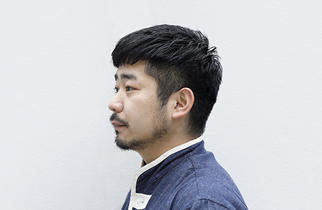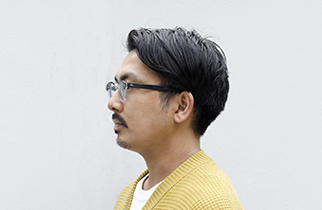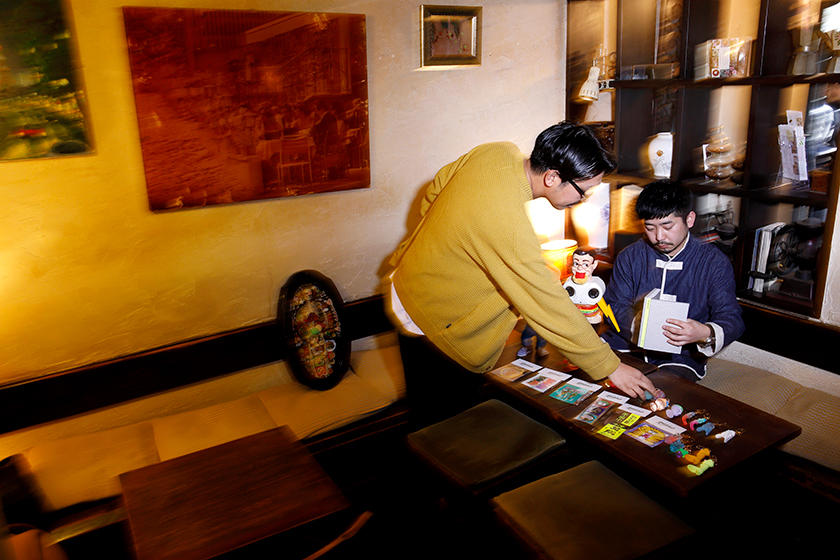
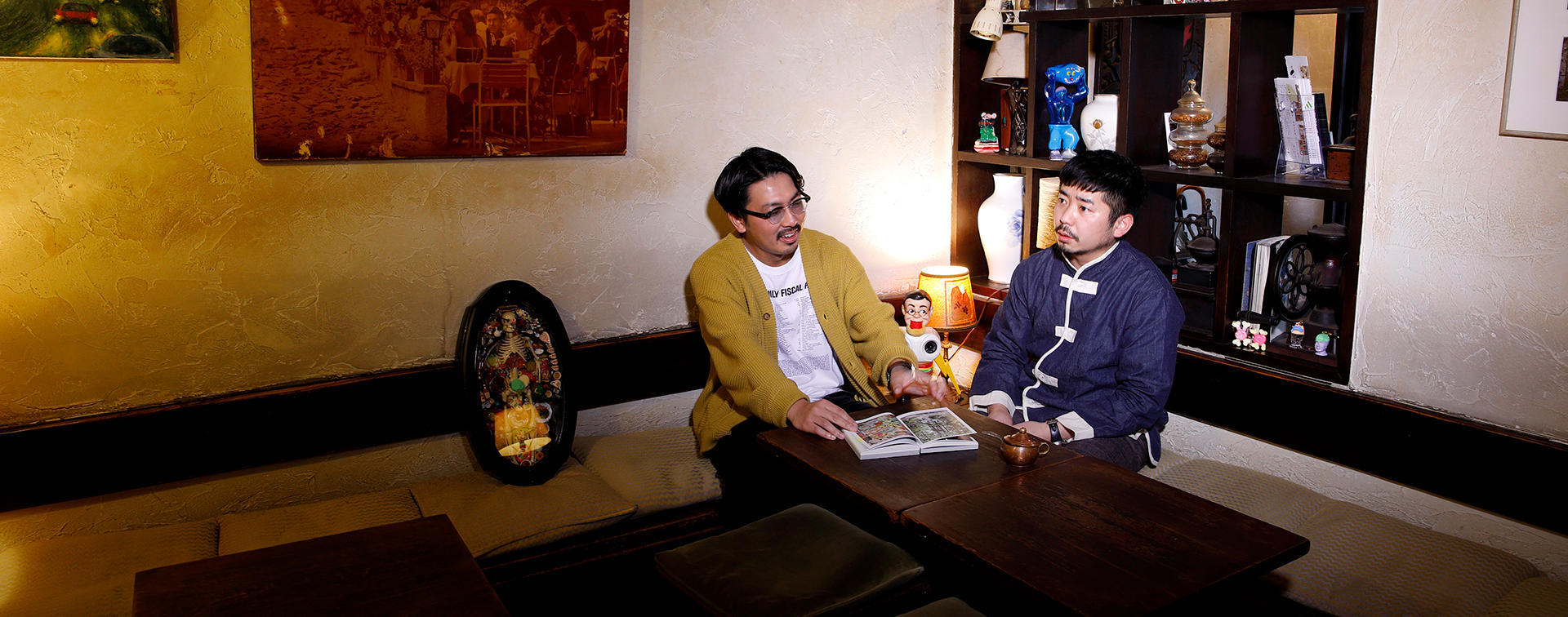

INTERVIEW
113
magmaArtist Unit
We’re going to make the world’s biggest collage, something that is loved by the public
Reusing things with different aesthetics and from different eras to create new value.
Their unique works let you know with a single glance that it is magma who made them. Jun Sugiyama and Kenichi Miyazawa - the duo who are collectively known as magma - work by finding and gathering scrap, unwanted electrical appliances, and other things that have come close to the end of their life yet have something interesting or appealing about them, and combining them through a process of sublimation to create something that has never seen before. Here we talk at length with the duo about their creative process, the way they choose their materials, and how they see themselves going forward.
We get a feeling for the "moment the other person" is in now and embody this inspiration in physical form
MiyazawaWe first met each other when we were enrolled in the Department of Scenography, Display and Fashion Design at Musashino Art University. We'd both gone to university having taken a two-year break from education after leaving high school, which is not that common in Japan so you feel a bit ashamed to talk about it, and there was this small but irreconcilable gap between those who had gone straight to university and those of us who hadn't. The number of people who had taken a break was extremely small, and there were only five or six of us who had taken two years out. We just ended up forming a group separate from the students who came straight out of school.
SugiyamaSo the fact that we got to know each other was just a natural extension of that. Those five or six students felt like one team.
MiyazawaWhile we were on that course this team did an exhibition, and while everyone had different tastes and interests we were the only two who felt like we had something in common. I think this contributed to us setting up shop together, and by the time we did our graduation piece we were already working under the name magma. By the way, the first name we worked under was "BOMBERS", but we decided to go with a name that has more of a 'boiling' image(laugh).
SugiyamaWe've worked together for more than 10 years since we were students, so I think we have successfully nurtured a shared way of seeing things, and this manifests itself in our daily conversations and in some aspects of our work. When we are doing something, in many cases we divide the work up in a way whereby I'll be making such and such while Miyazawa works on some other aspect. In this style of working we decide most things together at the start, and once we've decided on a theme, we can work with we go off and are free to create in whatever way we please.
MiyazawaIn an exhibition called SYMVOL, for example, once we'd decided upon a theme we went off and did our own thing. For that exhibition we took things that we felt to be symbolic - like Marilyn Monroe, the Michelin Man, and signs from construction sites - as the motif, and after we made something using these things, we put them into a single space to ultimately create our piece.
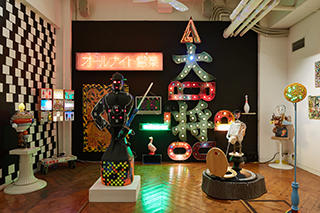
SYMVOL
A symbol, when left alone, will change in terms of its meaning, and at some point it will no longer fulfill its role of being a "mark" before being quietly forgotten. magma works based on the theme of how humans go about living a life that makes them human by continuously creating their own symbols went on exhibition in 2016 at VOILLD in Tokyo's Nakameguro area. For this exhibition, magma breathed new life into old symbols that were on the verge of disappearing by giving them a new form.
SugiyamaAlso, when it came to making products for use in the cover photo for the song TOWA by Yuzu, we first just decided the direction we would head in and the scale of the products, and then worked separately on the production. We also create pieces together, of course, but even when we do, we often divide the roles for some parts of it. To celebrate the tenth anniversary of our starting to work together professionally we recreated a university graduation piece we had called Future Shock, and we divided the work up with me being responsible for the fabric-like soft parts and Miyazawa doing the other rigid parts in the same robot.

TOWA
The cover photo for Yuzu's 13th album TOWA features products created by magma, and here again you can see how each member created their works in line with the chosen theme to create a single worldview. magma also collaborated with Yuzu on the 2015 single Owaranai Uta, and for this they produced 20 marionette clock themed analogue robots which gained much attention for their life-like movement in the music video for the song.
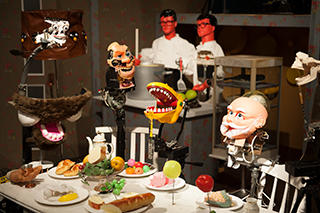
FUTURE SHOCK
This was the piece that magma created together as their graduation piece. It features humans and robots at a dinner table in a room, and a range of fake food, furniture and other items made using different types of scrap. It depicts a scene from a future where humans have become robot like, and features, among other things, robots that make noise and move in a fascinating manner and humans that serve food to the robots. magma restored this work for their 10th anniversary exhibition at La Foret Museum in Harajuku, Tokyo.
MiyazawaThe fact that we are able to do this is because we normally both work in the same studio, and I think that being able to see what each other is doing in real time is a big factor in our work. It enables us to bring variation to our work and ensure we don't do things that are too similar. The adlib style we have where we think "if he's going to do that, then I'm going to do this" is part of the fun of working together.
SugiyamaWe can look at the work being done, and see what kind of moment the other person is in now. I think always being in a fluid situation by constantly interacting as we create a piece is a very significant part of creating things together.
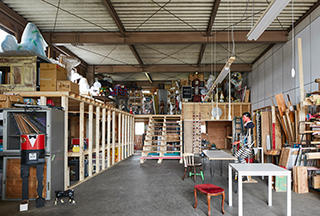
Atelier
The duo's Atelier is a vast, spacious warehouse that magma themselves turned into a space that is uniquely theirs. It boasts large shelves created from trees under the high ceiling, and packed with a large volume of scrap and electrical appliances and a range of materials it is almost as if they have created a secret base they dreamt of as kids. It has space for making small objects, a wood working space, and dedicated spaces for a variety of other activities.

The creations of these two contrasting individuals melt together to form a single piece
MiyazawaI think perhaps we are opposites, both in terms of what we make and our personalities. In terms of skills, making something dead straight and cutting things in straight lines is not my cup of tea. It's not really a matter of ability or being not good at it, I just think when I look at myself that this way of making things doesn't suit my temperament.
SugiyamaOn the other hand, I'm not really good at making things spontaneously. For example, if I try to draw a line that wanders in the way paint drips, it always looks really contrived. So, if that's the case I just think I might as well draw a straight line. But Miyazawa is one of those people who can just do things on the spur of the moment and make them look natural.
MiyazawaWhile you can probably tell from our works, you will definitely be able to tell from our handwriting that we are polar opposites. My handwriting is really really bad(laugh). But it's good that we're opposites as I get the feeling that if we were the same type of person we wouldn't get on because our personalities would overlap.
SugiyamaWe might start to hate each other because we were the same type of person(laugh).
MiyazawaIt wouldn't matter if you have a shared way of seeing things, you'd still probably end up trying to accommodate each other in this weird way. I think it offers a better balance if you have similar things you want to make and similar goals, but the things you make, and your personality are contrasting. Talking about it here has reaffirmed this to me.
SugiyamaThis style we've had of making things separately and putting them together to make a single piece is something we've had from the start. We didn't sit down and decide this was the way it was going to be, it just came about. And I think what that means is this is surely the best way for us.
MiyazawaBut while we make things separately, our ideal is for viewers not to be able to tell which of us made what, and that's also what we aim for.
The rush comes the moment that value manifests itself, and the moment that notions people have come tumbling down
MiyazawaOur works uses scrap that comes from things people no longer want and have dumped, and the starting point for this is probably in our university days. There was a department that used to make things out of wood, and the chairs and other things that students had made were dumped within the university when the exhibition was finished. I really used to like finding weird chair from among these and modifying them. These really weren't good chairs, and it was presumably because the person who made them also felt this way that they were dumped. But it is this feeling of something missing that maybe stimulates my creative desire. I like it when the techniques involved are not something I could do myself and when nice materials are used.
SugiyamaI have always been interested in old things. I don't just mean antiques; I'm also talking simply about things that were made a long time ago. For example, I'm really drawn by wooden products that were made a long time in the past. I find it fun to replace the wood with plastic to make the thing new, and to take it to a new level by combining it with modern materials. Of these things I like things that are old but don't feel old and things that truly feel handmade, and I can't help but pick them up.
MiyazawaIt's a reflex action when I actually choose something, but I really place a lot of importance on the feeling I get when the potential of something makes me excited. If it's something that is complete then I just feel that it is fine the way it is, and the feeling of something missing that I mentioned before is the element that makes me excited. I sometimes only pick out parts of something. For example, (points at a lamp on a table in the establishment) if I thought this lamp shade was nice, I might consider making the other parts myself from scratch. And if the original item is something that I couldn't make myself it makes me more excited. I think that I just like using things that other people have made.
SugiyamaIt also makes me happy when we display things in a different form as a work, and the people looking at it realize what the scrap stuff was originally and go "oh, I know what this was." What this means is that something has been deemed unnecessary and fallen to its lowest point in terms of value, but then when it pops back into someone's thoughts by being rediscovered there is a moment when its value is reconsidered.
MiyazawaThe moment when people's notions change is also interesting, I feel. Some of our work take clocks as the motif, and this came about through a realization that marionette clocks are the same as a picture in a frame. If you have hands that move and numbers, you have a clock. So, based on this, we did things like pulling out the hour and minute hands to leave just the second hand and put a picture in an alarm clock. I love the moment when people's notions are changed not just through combination or modification but through replacement. It's a great feeling when people who view the works think "oh this can also be a clock," and we've succeeded in changing the way they think so that the next time they see something they will see it in a different way.
In Japan, things that have a purpose sell. But it is needlessness that is interesting.
SugiyamaAs magma we do both purely aesthetic artwork and work for clients, but the basic approach is the same. But of course, there are some aspects in which our methods change if we are doing a shoot for a piece for a client.
MiyazawaFor example, when you're shooting with a camera only the front can be seen so the rear can be just a wooden frame. This way of creating is unique to work for clients, and the freedom to just go all out as you please are quite refreshing(laugh). But when it comes to our own works, someone will buy it and take it home where they can examine it in detail, so you can't neglect any aspects of it.
SugiyamaWe also work in different ways on our own projects depending on what we are making. For example, large things like furniture and things like key holders and stickers are completely different for the people who have them, and the standards they apply to determine if they can use them or not are also different. We keep making these things, but I think that especially in the case of large things like furniture, the people who buy them want to be able to use them in some way.
MiyazawaMost Japanese people buy things that have a use; they won't buy anything that is just for decoration(laugh). In terms of furniture, CIBONE was good just around the time we graduated from university. There were things made by stacking up scrap wood and giving it a thick coat of paint, and a massive model horse with an umbrella lamp on its head, and many other things that were bizarre and interesting and really influenced us.
SugiyamaBut then we slowly came to realize that people wouldn't really pay attention to things that they couldn't use.
MiyazawaAs a result of this we started to think about everything, including "usable art". But on the other hand, even though stickers and key holders and things like that are completely non-functional, people tend to take them without thinking about it too much even if they are quite heavy(laugh). Furthermore, such things have the potential to stimulate communication when people see others with them, like when a person I know was out and about with a magma key holder on display they said that someone who they had never met before started talking to them on the train. I think that's the difference. In terms of displaying taste and style, things like stickers and key holders that people display on themselves are also fashion items.

Key holders
Key holders can perhaps be described as magma's standard product. They have a range of series including ones called Namplar and Golden Gym, and each one is made by hand. With a typical magma use of color and an interesting design, they have the unique feeling of one off products and sell out in the blink of an eye.
SugiyamaYou're right. Functionality is, of course, important for furniture and other such things, but I just really like needlessness. There is also probably quite a lot of this in the things we use every day(laugh). I think I just quickly get bored with things that have a clear purpose for use.
MiyazawaI actually just stopped by an American furniture store called Pacific Furniture Service. There I found this spoon with a clip on it that you could use to keep a bag of coffee beans closed. This seemed really American to me and I just thought it was...... needless(laugh). But I found the idea of killing two birds with one stone to be quite interesting. I also like camping. It's cheaper to stay in hotels, and you have to get all your heavy camping stuff together and make the effort to drag it to somewhere that's hard to get to just to go to sleep, so I think it's the epitome of needlessness. But at sunset when you have a fire going, it is such a good feeling and it really makes you want more.
SugiyamaI really know what you mean about the needlessness of camping. This is a pretty extreme opinion, but ultimately, I think the strongest motivation here is creating something needless that makes people go "wow, this is great." It would be great if we too could make things like this.
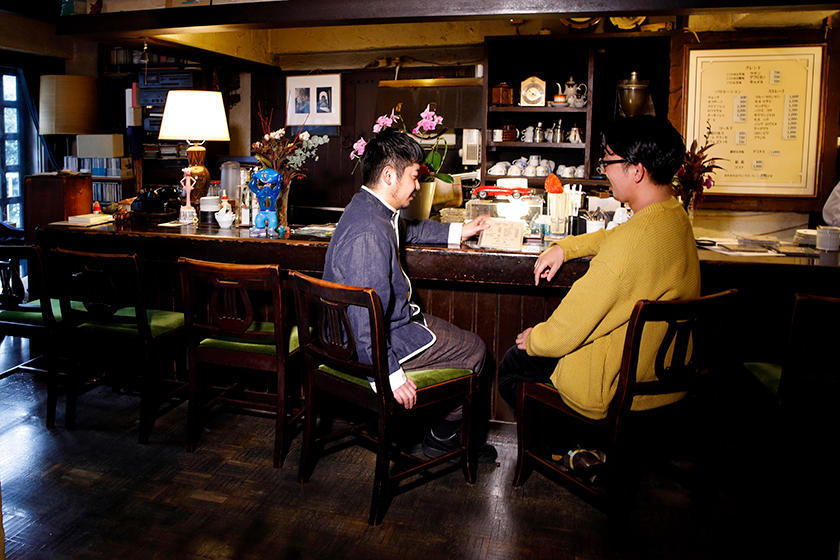
What we'd really like to make is a symbolic landmark.
MiyazawaI don't think it's bad for there to be needless art around towns and the places people live. For example, it would be interesting if there were something like the Nazca Lines at an airport so people could see it from a plane after taking off. Like, something that you gradually come to see the higher you get. It would be great if buildings in an urban area such as Roppongi were arranged to form a picture that can be seen from the top of a tall building. It would take a massive amount of money, but in some ways, the needlessness would be good(laugh). Although it's on a smaller scale, magma has a work in which you can see an image when you view it from above, and the moment the viewer goes from "what's this?" to "oh, I see it" is really good. It's something you can only experience once, though.
SugiyamaIn terms of urban art, the golden thing you can see on the roof of the Asahi Breweries building in Azumabashi near Asakusa in Tokyo is very interesting. Everyone loves that(laugh). It's amazing how they managed to put something so big and heavy up there, and while it is loved as a symbol of the company it has attracted questionable nicknames such as "the golden turd" and "the poo building". But, it's adorable(laugh). You don't really see this kind of thing very often, so I really like it.
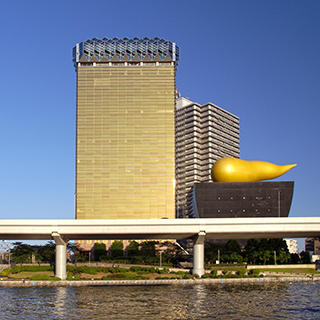
The Asahi Flame (Flamme d'Or)
The Asahi Flame is a construction on the roof of the Asahi Breweries head office building on the banks of the Sumidagawa River in Tokyo. A restaurant was constructed to commemorate a century since the founding of Asahi Breweries and was called Flamme d'Or, which means "golden flame". Built at the same time, the construction on the roof was designed by the global French designer Philippe Starck and also features a golden flame theme. The shape has a variety of nicknames, but it is a work that is loved by the public and the people of Tokyo.
MiyazawaIt's not really Japanese, is it. While this is something that we have been saying for a while, we want to create something symbolic that everybody recognizes as a meeting place. And if we are going to do it, I'd like to make something big even if it does appear stupid at a glance. I'd like it to have an atmosphere that gives people courage when they see it. I'd also like to make something that is loved by the public and is printed on souvenirs from the place it stands.
SugiyamaI see, I wonder what would be good for the material.
MiyazawaI'd love to cut up construction and fairground ride materials with different aesthetics and from different generations, and put it all back together in a different form. The world's biggest collage. If possible, I'd give it a short name so that people would say, "see you in front of XYZ"(laugh).
SugiyamaThe shorter it is the better, definitely(laugh). The impulse and motivate to keep making things are different for each person, but for us I think we are definitely the type of people who just like to make things. It's not as if we have no message to convey whatsoever or no rebellious spirit, but we just find pleasure and joy in the actual making of things. We just simply really really love physical products(laugh).
MiyazawaThere are many people around us who work using a computer, and there isn't really anyone who uses physical things to create three dimensional objects. Of course, there are loads of great works that use video, CG, and things like that, but when I see a CG work alone, for example, I just feel.... like I've passed through it. A long time ago, a teacher at the art prep-school I went to told me "it's not about just being skilled in making good looking paintings - the ones that you feel in your stomach are best." This way of expressing things really had an impact on me, and I want to, as he said, keep making things that people feel in their stomach. I am confident that we won't fail in this challenge.
Editor's Thoughts
The duo very kindly and thoughtfully made the effort to bring along two pieces of their work to the interview, and although they were heaving and bulky, they brought them because they said it would make it easier to talk if they had examples. When I saw their works up close, I was struck by an impulse that really made me want them. Their works, which have a colorful modernity about them while also having a nostalgic aspect, have both a core and meaning, and instead of a strange aggression they are full of an abundance that steals your heart. While they described themselves as being opposites, I felt that the things they had in common and linked them were their calmness, their human qualities and the passion that lies within them, and the strength to say without hesitation "we won't be beaten by anyone." (text_akiko miyaura)
RANKING
ALL
CATEGORY




